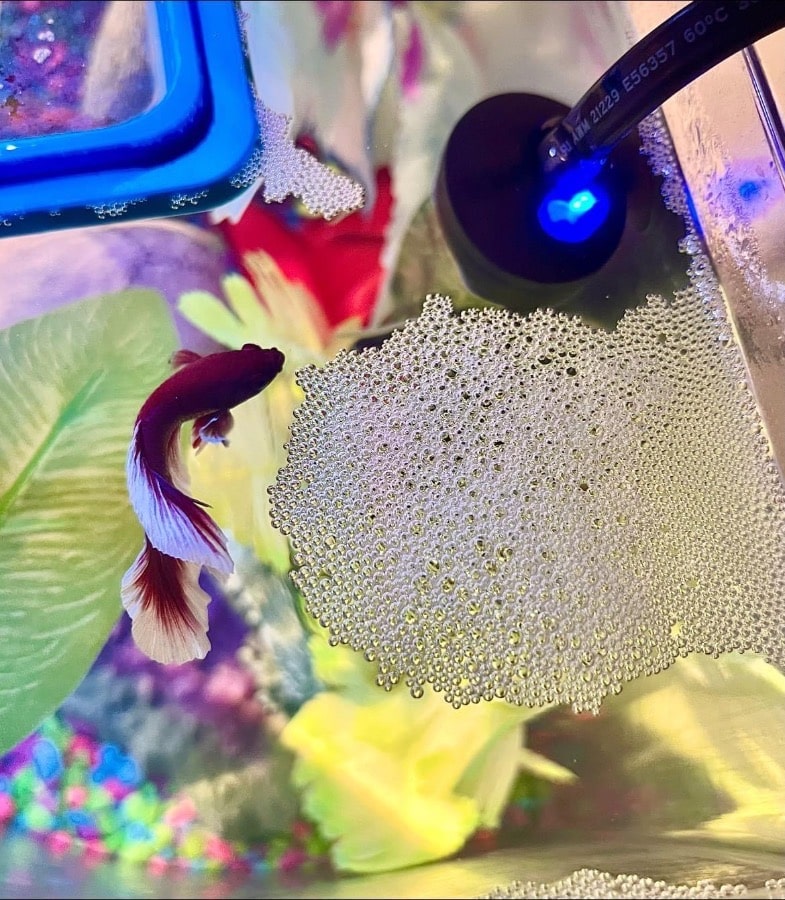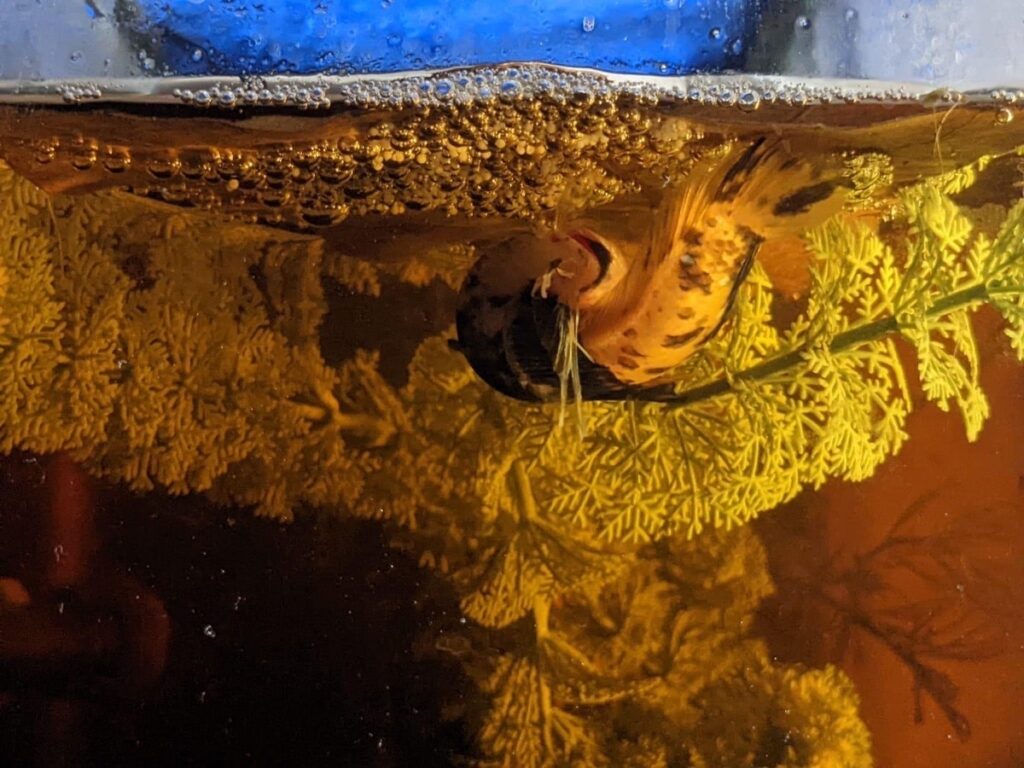Many Betta keepers wait for the day with bated breath, while others are caught by surprise: a strange film of bubbles appears on the surface of your Betta’s tank.
No, the fish tank doesn’t need to be cleaned and it’s not even coming from your air stone or bubbler. Your Betta Splendens has built a bubble nest.
Bubble nests are another cute little feature of our favorite fish. But why do Bettas build bubble nests, and what do they mean?

What’s a Betta Bubble Nest?
Betta bubble nest is a layer of foam composed of bubbles that floats on the surface of the tank. Male Betta fish typically build these nests in the corners of the tank or where plant leaves reach the surface (1). This is because the nest is less likely to float away when it has something to attach to.
Bubble nests are an important part of the Betta breeding process. The male Betta builds the nest to house the eggs that are spawned by the female. Once the eggs are spawned, the male carefully moves them to the nest using his mouth. This is where the young fish, known as fries, are born.
The size and thickness of bubble nests can vary greatly. Some nests may consist of just a few dozen bubbles, while others may be made up of hundreds of bubbles that span several inches across the surface of the tank. Some male Bettas take great care and aggressively defend their nest from other tank inhabitants, while others are more relaxed and build smaller nests.
Building a bubble nest can be triggered by a variety of factors, including the presence of a potential breeding partner or even just the presence of a passing female Betta. Even in the absence of a breeding partner, domesticated male Bettas may still feel the urge to build a nest.

How Does Betta Build a Bubble Nest?
Betta fish build a bubble nest by blowing bubbles made from air and mucus. These bubbles are built around floating plants or debris. Betta fish have a labyrinth organ that allows them to breathe air from the water’s surface. They use this organ to blow bubbles with their saliva.
Why Do Betta Fish Make Bubbles?
Betta fish blow bubbles as a natural reproductive instinct, regardless of whether it’s mating season. Male Bettas usually blow bubbles to signal to female Bettas that the male Betta is ready to breed and to attract potential mates.
Betta fish, also known as Siamese Fighting Fish, are unique in their parenting behavior. Unlike most species of fish that leave their eggs to float in the current or bury them in dense plants, Bettas take care of their eggs once they are laid.
The bubble nest provides a safe and secure environment for the eggs to hatch and for the fry to develop. The floating bubble nest keeps the fries close to the surface of the water, where there is more dissolved oxygen, which is important for Bettas as their natural habitat is tropical standing waters that are oxygen-depleted (2). Additionally, the bubble nest and plant debris it collects, keep the fries safe from drifting away as they are not strong swimmers.
Does Building a Bubble Nest Mean My Betta is Happy?
Building a bubble nest is a natural behavior for Betta fish, but it’s not a definitive indicator of the fish’s happiness and health. Even Bettas kept in small cups or unhealthy Bettas may still build bubble nests, as it’s a reproductive instinct.
However, if your Betta fish also displays other signs of good health such as vibrant colors and normal feeding habits, then the presence of a bubble nest can be considered an additional positive sign. Observing this instinctive behavior can be enjoyable for Betta fish owners.
Betta Breeding Behavior
Betta fish have a distinct breeding behavior. They build bubble nests as a part of the courtship ritual (3). Male Bettas flare their gills and spread their fins to attract a female. They also perform a mating dance to gain the female’s attention. If a female Betta is receptive, her colors darken and she develops dark vertical lines, known as “breeding bars.”
The male Betta wraps himself around the female until she releases eggs. He fertilizes the eggs in the water before moving them to the bubble nest. The female’s role is complete at this point. The male stays to guard the eggs until the fry hatch.

How to Encourage Bubble Nest Building – Best Conditions
To encourage bubble nest building in Bettas, provide the following conditions:
- Maintain the proper temperature range between 78-82 degrees Fahrenheit and ensure proper chemical balance in the tank, with ammonia and nitrate levels at or below 0.5 ppm, and nitrite levels no more than 20 ppm.
- Provide an engaging natural environment with plants and hiding spots for your Betta to explore.
- Avoid disturbing the water’s surface with a strong current, as Bettas in the wild live in still or slow-moving warm water.
- Keep the water clean and clear of debris, and consider using floating plants like Crystalwort or Elodea to provide an anchor for the nest.
- Introduce a rival male Betta in an adjacent tank to encourage competition and show off behavior.
- Introduce a female Betta to the tank to encourage breeding behavior and the building of a bubble nest.
What Should I do if My Male Betta isn’t Making a Bubble Nest?
If your male Betta fish isn’t building a bubble nest, it could be a sign of injury, illness, or stress. Check for signs of injury or illness such as faded colors or damaged fins. However, it’s worth noting that as Betta fish age, they may stop building nests.
If your Betta appears healthy, the conditions in the tank may not be suitable for nest building. To encourage bubble nest building, ensure the conditions in the tank meet the requirements discussed above.
Should I Remove Betta Bubble Nest?
It’s safe to remove the Betta bubble nest if there is no female Betta for your male Betta fish to mate with or if it’s causing environmental disturbance or you need to perform a water change. However, if the bubble nest is not causing any issues, it’s best to leave it in place as it’s a natural aspect of their mating behavior.
It’s important to note that bubble nests can break up naturally if they aren’t removed during a water change. These nests typically last around a week before breaking apart due to factors such as plants, debris, and currents caused by filters.
What Happens if a Betta Fish is Interrupted When Building a Bubble Nest?
Betta fish can become stressed or aggressive if interrupted while building a bubble nest. This behavior is controlled by instinct and is part of a Betta’s reproductive urge. Signs of stress can include flaring gills and refusing to eat. To avoid disrupting the Betta, it’s best to leave it alone while it builds its nest. Even disturbing the surface of the water can upset the Betta.
Frequently Asked Questions About Betta Fish Bubble Nests
Do Female Betta Fish Make Bubble Nests?
Female Bettas do make bubble nests, but it’s rare. In the wild, it’s typically the male Betta’s responsibility. In captivity, a female Betta may make a bubble nest if there are no males present. Some fishkeepers suggest that female Bettas build bubble nests to indicate they are ready to breed, but this theory isn’t confirmed.
It’s also possible that your female Betta is actually a male or the bubbles being created are simply a byproduct of breathing rather than an attempt at nest-making. It’s important to not assume that a female Betta is building a bubble nest without proper observation.
How Often Should Betta Fish Make Bubble Nests?
The frequency of bubble nest building in Betta fish varies. There is no set normal rate or size for bubble nests. Each Betta fish builds its nest differently.
However, a Betta may build nests more frequently if it’s stimulated by nearby females. Even in the absence of females, a male Betta may still have the urge to build a nest. This behavior is normal and natural.
If your Betta is not building any bubble nests, it isn’t a cause for concern as long as its habitat and water conditions are optimal.
Conclusion
Bubble nests are a common behavior in labyrinth fish such as Bettas and Gouramis. If you see a raft of bubbles in your tank, there is no need to worry.
Male Bettas have a natural instinct to build bubble nests, even when there are no females present.
As a fish keeper, observing this behavior in your tank is a privilege. It’s an enjoyable aspect of keeping Bettas and watching them follow their natural instincts.